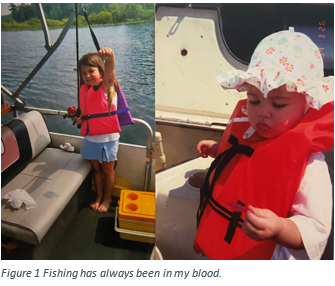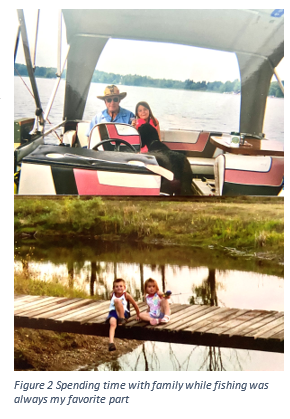
Savannah Obert-Pfeiffer is a soon-to-be third year student majoring in Sustainability Science and Society. The following blog was written as part of the Department of Social Sciences’ Undergraduate Program for Exploration and Research in Social Sciences (UPERSS) at Michigan Tech University.
What was your UPERSS project?
For my project I created a StoryMap website to represent a Social Sciences Department graduate student project titled, “Connections: Stories from Women Who Fish”.
Why did you use StoryMap rather than creating a “regular” website?
StoryMap is a platform that can be used in many different ways, including creating a web page designed around a specific map, it can be used like I did with more of a website but fun and interactive pieces, as well as making it a guided tour of the webpage. StoryMap is a good platform to use to portray information in a very personal way, rather than just scrolling through a one dimensional website StoryMap can take the reader with the creator on the journey of what the website has to offer. It is easy to work and play around to add fun experiences like moving text while the pictures stay until the next paragraph is ready. I would highly recommend StoryMaps because I have worked with many website platforms but nothing as creatively independent as StoryMap.
For the purpose of this particular project I used StoryMap to share background on the project, information about what Photovoice methodology is, and display women’s fishing stories and images (combined as “photostories”) in an interactive map showing some of these anglers fishing spots. I used the information that Erin Burkett (PhD, Environmental and Energy Policy, ‘19) had compiled for her graduate research and condensed it with the information she felt was most important to have on the website. Rather than focusing on women’s fishing participation rates or large-scale patterns among recreational anglers, I focused on sharing information produced by 15 women who participated in the photovoice project. The emphasis is on their unique experiences and perspectives. There were a lot of photos that anglers gave to Erin and I wanted to show off as many as possible while still keeping it interactive, which is why I made the map. For me this was the highlight of being creative with the website because it gave me the opportunity to see what I could create and I really enjoyed the process.
Why did you want to work on this project?
At a young age I would always go fishing with my mom and grandparents on their pontoon, as well as with my dad at our family friends’ pond. My life was highly influenced by these trips and as I got older I slowly stopped, which makes me sad. When I saw this project on the UPERSS project page I knew I wanted to do something, It had such a meaning to me that I honestly did not realize I missed it. This project was something that seemed like a really fun activity to do and I was right.
Also, it is exciting to think about having a website that can bring joy to people that were involved. Other people that saw the process of Erin’s project, even some of my friends, wanted to look at it because they were so impressed by the fish these women caught.
What was challenging?
I remember when I was starting out I was so scared of making something for someone that compiles a lot of what their graduate project contained. I was also very nervous to step out of my comfort zone with getting involved and meeting with her, but it was amazing in every way. I highly recommend any undergraduates that have the opportunity to start on a project that they feel passionate about, because if you are interested in the topic it makes discussing it that much easier. Also being proud of the end product helps to gain a strong support system, by growing better relationships with professors and others who can help out later in my career. A challenge I had with the actual process of the website was at one point the map I created would not show up anymore, so I had to recreate it. It is not hard work but it was frustrating to know that the part I spent the most time on was gone. A personal struggle I have was tracking my time, I found it somewhat like a stress reliever to work on after or before I finished my other homework, so I would just start working on it and 20 actions and changes on the site later I would realize I had no idea when I started. So, for anyone that is looking to do this type of project and needs to track hours put a text in at the top of the site so that when you start working on it you will see that note and just look at the time, then delete it before publishing.

What did you learn through the course of this project (knowledge, skills, etc..)?
Some of the key points that I learned from this project are how to use story maps, I have never used this before so I had a lot of fun. I also learned about working with people and trying to collaborate, it was a very good learning curve.
How will you apply what you have learned in the future?
This process will definitely benefit me because of how I learned how maneuvering different platforms for creating content can be very beneficial, as well as knowing more people, and just getting my name on something that I can show people. I would highly recommend undergraduates to participate in UPERSS personally, I know I will be in the future so this was a fantastic starting point.